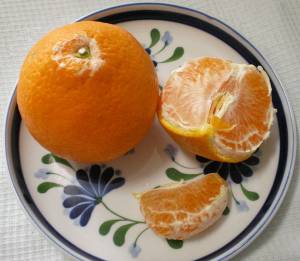With its clearly defined seasons and dedicated farmers, Japan is home to many varieties of sweet fruit, many of which have been introduced from abroad and are recognizable to foreigners, while others are native to Japan and not as well known outside of East Asia. The most common way to encounter fruits in Japan is as dessert at the end of a meal.
In this episode, we take a look at some beautiful and delicious Japanese fruits.
 Long ago in Japan, fruits were called "water sweets." They were popularly categorized as confections in Japanese culture. Such fruits included persimmons, nashi pears, peaches, ume, Chinese apples (Malus asiatica), grapes, and so on. Prior to the Meiji era (before 1868), persimmons and nashi were the main fruits that people enjoyed.
Long ago in Japan, fruits were called "water sweets." They were popularly categorized as confections in Japanese culture. Such fruits included persimmons, nashi pears, peaches, ume, Chinese apples (Malus asiatica), grapes, and so on. Prior to the Meiji era (before 1868), persimmons and nashi were the main fruits that people enjoyed.
From the Meiji era on, many types and varieties of fruit were introduced from abroad and started being cultivated in Japan in a form adapted to the Japanese climate. A number of Japanese citrus fruits are grown in or strongly associated with Japan. Many of these fruits are of Chinese origin, but have been modified or specially bred for cultivation in Japan.
Japan is a long, narrow country with much steep, rugged terrain. The amount of arable land per farming household is small and the high-mix, low-volume production comes with high costs. So there is a focus on selecting and cultivating varieties that both look and taste good, which is important for table fruits. Also, because of the custom of giving fruits as gifts, they are presented and sold as regional specialty items at luxury fruit stores located in the most prestigious urban areas, and even handled as luxury goods overseas.
The volume of fruit production in Japan 2006, including fruit trees, watermelons, melons, and strawberries, totaled approximately 3.85 million tons. In order of higher production, the fruits were mandarins (mikan), apples, watermelons, nashi, persimmons, melons, grapes, strawberries, peaches, and ume. In terms of fruit production volume, the most commonly grown fruits in Japan is also produced widely in other parts of the world.
In apples, the variety with the largest production in Japan since 1981 is the Fuji apple, which has won worldwide attention for its quality. Japan currently has the largest production and consumption of dessert strawberries in the world. Their color and shape are truly outstanding and they are available almost anytime throughout the year, although the best season is from January to March.
Melons are the prototypical luxury fruit in Japan, and is often given as a high-priced gift. Nonetheless, moderately priced melons are more common. A wide variety of melons is available in Japan, including green fleshed melons like muskmelons, orange fleshed melons like cantaloupes and even white and yellow fleshed varieties.
Episodes:
 |
JAPANESE CUISINE: We introduce you to the well-balanced Japanese menu and meal style. |
 |
JAPANESE RICE: The pursuit of delicious rice to this day remains an ongoing national passion. |
 |
SEAFOOD: The Japanese are masters at unlocking the flavor of the ocean bounty. |
 |
VEGETABLES: Japan has a variety of unique vegetables. We take a look at some delicious & healthy Japanese vegetables. |
 |
GIFTS FROM THE FOREST: Japanese have accumulated knowledge of producing high quality mushrooms and charcoal. |
 |
JAPANESE BEEF: Discover the secrets of the great taste of Japan's Wagyu, now an internationally recognized brand of beef. |
 |
JAPANESE GREEN TEA: Japan is extremely proud of its traditional drink. For generations, it has been indispensable to their way of life. |
Contact Us | Shop | Sitemap | Join Our Team | Investors | Advertise | Web Design Services
Community | Foodies' Choice | Meetup Groups | Chat | Blogs | Forums | Submit Your Site | Resources
